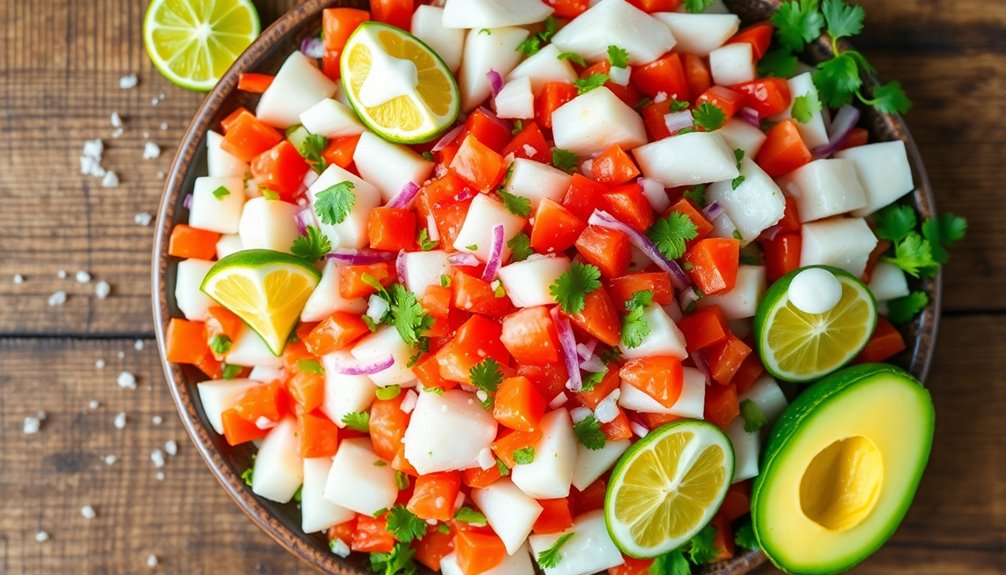Kinilaw is a vibrant Filipino dish that features fresh, raw seafood marinated in tangy calamansi juice and vinegar. It's been a part of Filipino culture for over a thousand years, showcasing traditional preservation techniques. Sashimi-grade fish is a must for freshness, while aromatic ingredients like ginger and red onion add flavor. Typically served chilled, kinilaw can be garnished with fresh herbs for added appeal. Stick around to discover more about its preparation and cultural significance.
History
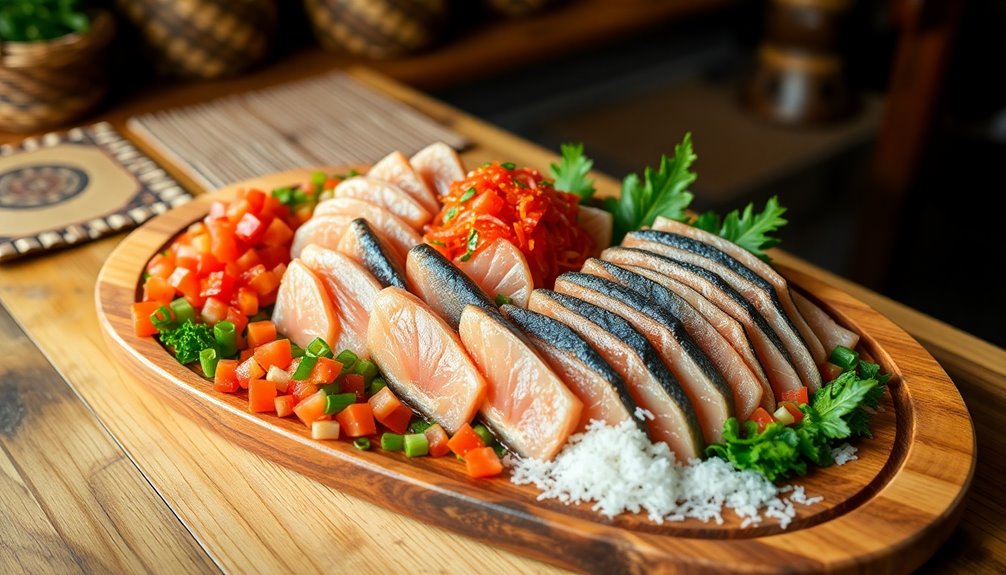
Kinilaw has a rich history that dates back over a thousand years, showcasing its significance in Filipino culture. This traditional dish highlights the ingenious ways our ancestors preserved fish using vinegar and citrus, setting it apart from Latin American ceviches.
In the 17th century, Spanish colonists took note of kinilaw, documenting its unique preparation methods. As you explore the diverse regional variations—like kinilaw de Oro and binakhaw—you'll see how local ingredients influence flavors while maintaining core traditions.
In Northern Luzon, the term "kilawin" encapsulates a range of raw or lightly cooked dishes, illustrating kinilaw's adaptability. This evolution reflects not just culinary creativity but also a deep connection to the land and sea, emphasizing the importance of fish in our heritage. Additionally, understanding advance directives can guide families in making informed decisions about food and traditions as they navigate the complexities of elder care.
Recipe
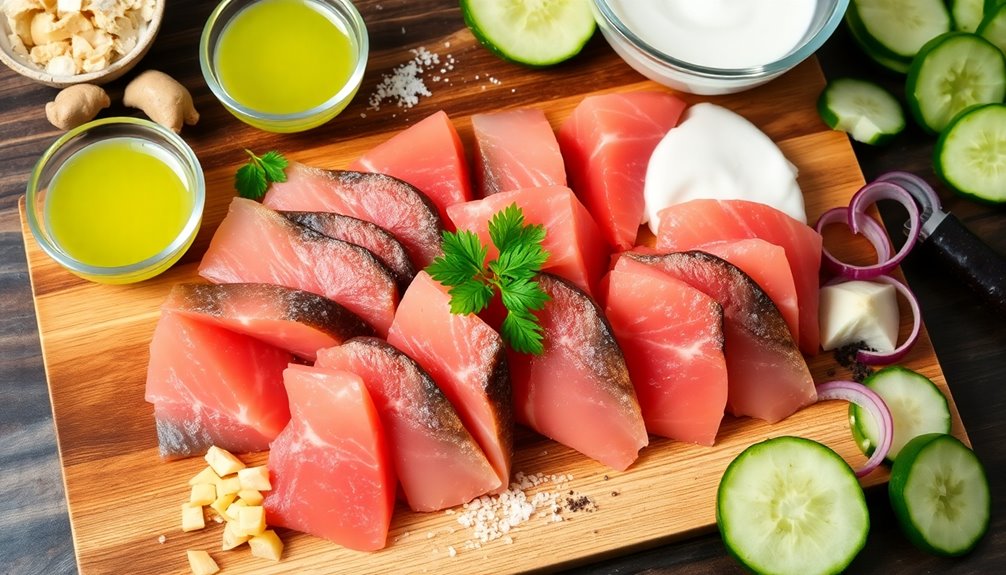
Kinilaw is a traditional Filipino dish that showcases the freshness of raw fish or seafood, marinated in a tangy mixture of calamansi juice and coconut vinegar. This dish is often enjoyed as an appetizer or side dish and pairs wonderfully with ice-cold beers, making it a popular choice during gatherings and celebrations.
The key to a great kinilaw is using sashimi-grade fish, ensuring that the ingredients are fresh and of high quality. This dish not only highlights the flavors of the fish but also incorporates aromatic ingredients like ginger and red onion, creating a delightful balance of taste.
To prepare kinilaw, you'll start by finely chopping aromatics and marinating them in vinegar and calamansi juice to enhance their flavors. The fish will be cut into bite-sized pieces and washed in vinegar to eliminate any fishy odor before being combined with the marinated aromatics.
Begin by finely chopping aromatics and marinating them in vinegar and calamansi juice for a flavor boost before mixing with the fish.
The marinating process can vary in time, allowing you to achieve the desired texture preference. For those looking to experiment, adding coconut milk can provide a creamy texture that balances the acidity of the vinegar, resulting in a unique twist on this classic dish. Additionally, incorporating chia seeds can boost the nutritional profile of kinilaw, offering health benefits like enhanced satiety and fiber content.
Ingredients:
- Sashimi-grade fish or seafood (e.g., tuna, mackerel, shrimp)
- Calamansi juice
- Coconut vinegar
- Fresh ginger, finely chopped
- Red onion, finely chopped
- Salt
- Pepper
- Coconut milk (optional)
- Cucumber and bitter melon (optional, for variations)
Instructions:
Begin by finely chopping the ginger and red onion, then marinate them in a mixture of calamansi juice and coconut vinegar for about 10 to 15 minutes to enhance their flavors.
While the aromatics are marinating, prepare the sashimi-grade fish or seafood by cutting it into bite-sized pieces and washing it in vinegar to remove any fishy odor. Once the aromatics are ready, combine them with the fish in a bowl, season with salt and pepper to taste, and mix well.
Refrigerate the mixture for at least 10 minutes to 1 hour, depending on your preferred level of doneness. If using, add coconut milk for a creamier texture just before serving.
Extra Tips:
When preparing kinilaw, always ensure that the fish is sashimi-grade to guarantee its freshness and safety for raw consumption.
Experiment with different types of fish or seafood and consider adding fruits like mango or avocado for a refreshing twist. If you prefer a milder flavor, you can adjust the amount of vinegar used or incorporate more coconut milk.
Lastly, serve kinilaw chilled for the best experience, and don't forget to pair it with your favorite cold beverage!
Cooking Steps

To start making your kinilau, choose fresh, firm fish and slice it into bite-sized cubes.
Marinate the fish in citrus juice to enhance its flavor, then add your chopped aromatics and seasonings.
Finally, serve it with fresh herbs for a vibrant finish that elevates the dish. This dish can also be paired with rice dishes to create a more filling meal.
Step 1. Choose Fresh, Firm Fish
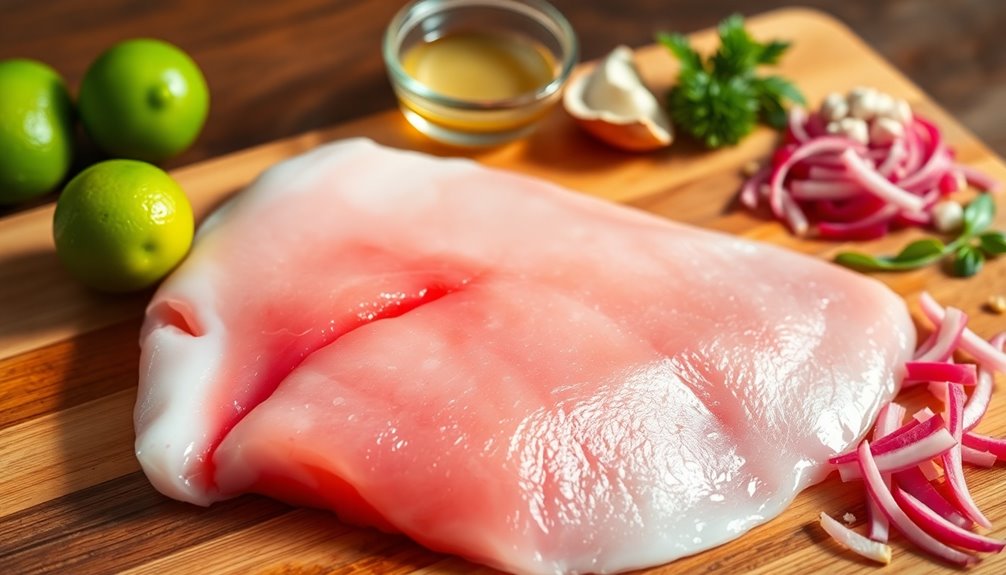
When preparing kinilaw, choosing fresh, firm fish is crucial for achieving the best flavor and texture.
Opt for sashimi-grade options like tanigue, malasugi, or tambakol to guarantee quality. When selecting your fish, look for flesh that's firm and has a clean, ocean-like smell—these are signs of fresh seafood.
Steer clear of any fish with discoloration, off odors, or a slimy texture, as these indicate spoilage. Ideally, purchase your fish within 24 hours of making kinilaw to ensure optimal freshness. This attention to detail will enhance your dish and elevate the overall experience. With fresh, firm fish, you're well on your way to creating a delicious kinilaw that's sure to impress. Additionally, incorporating high-quality nutrients from fresh fish can contribute to a well-balanced diet.
Step 2. Slice Fish Into Cubes

Start by rinsing your fresh, sashimi-grade fish in vinegar to enhance its flavor and preserve freshness. Choose fish like tanigue or malasugi for the best quality.
After rinsing, grab a sharp knife for slicing. Cut the fish into uniform cubes, about 1-inch in size; this ensures even marination and a pleasing presentation.
Remember, the key to great kinilaw is using fresh fish prepared within 24 hours of purchase to prevent spoilage. Each cube should be cut carefully to maintain the fish's integrity.
Once you've cubed the fish, it's ready to be combined with marinated aromatics for that perfect kinilaw experience. Additionally, pairing kinilaw with high omega-3 fatty acids can enhance the dish's health benefits. Enjoy the process, as fresh seafood brings a delightful taste to your dish!
Step 3. Marinate With Citrus Juice
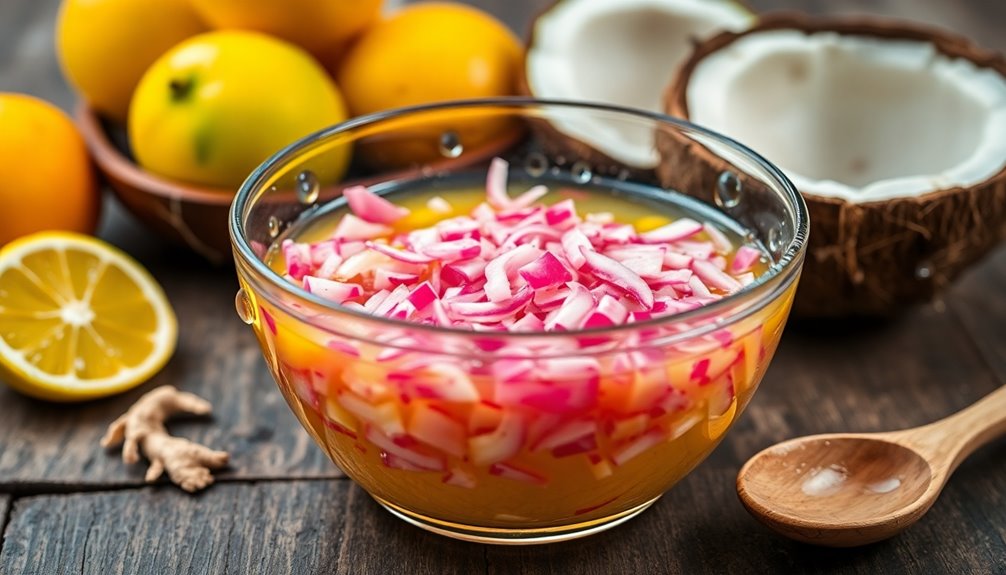
After cubing the fresh fish, it's time to enhance its flavor with a vibrant marinade.
To marinate with citrus juice, combine calamansi juice and vinegar in a bowl. This mixture not only adds a zesty kick but also helps "cook" the fish without heat.
For a tender texture, let the fish marinate for about 10 minutes; if you prefer a firmer texture, extend the marination to 1 hour. Using fresh, sashimi-grade fish is crucial for safety and quality.
The acidity of the calamansi juice will denature the fish and neutralize any fishy odors, improving the overall taste of your kinilaw. Additionally, ice cream consumption can often be a delightful contrast to the zesty flavors in kinilaw during summer gatherings.
After marinating, strain the fish to remove excess liquid before proceeding with the next steps.
Step 4. Add Aromatics and Seasonings
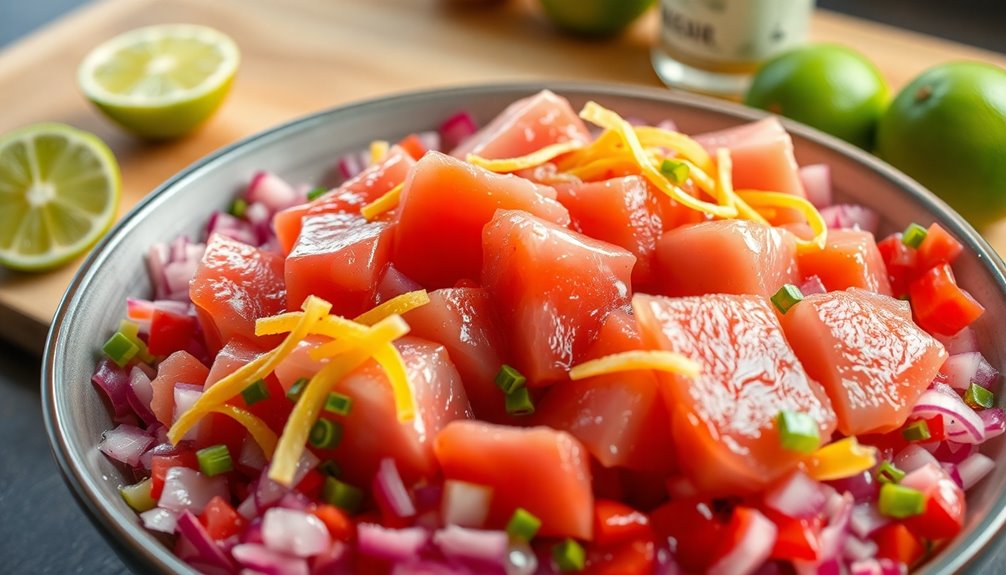
To elevate the flavor of your kinilaw, finely chop aromatics like ginger, red onion, and Thai chiles, then marinate them in a mixture of calamansi juice and coconut vinegar.
Pop this mixture in the refrigerator to let the flavors meld together beautifully.
Once ready, combine the marinated aromatics with cubed sashimi-grade fish or shrimp in a non-reactive bowl; this prevents any metallic taste from affecting your dish.
Season the mixture with additional vinegar, salt, and pepper to taste, adjusting according to your preference for sourness and seasoning balance.
Finally, allow the kinilaw to chill in the refrigerator until it reaches your desired level of "cooking" through the acid, usually between 10 minutes to 1 hour. Additionally, serving kinilaw with a fun and easy dessert like dirt cups can create a delightful contrast of flavors and textures for your meal.
Step 5. Serve With Fresh Herbs

While your kinilaw is chilling and absorbing those delicious flavors, prepare to elevate the dish further by adding fresh herbs.
Finely chop or chiffonade cilantro, mint, and basil, and sprinkle them on top just before serving. These fresh herbs not only enhance the flavors but also add a vibrant aroma that makes the dish irresistible.
To balance the acidity of the vinegar, consider incorporating green onions or chives for a mild onion flavor that complements the kinilaw beautifully.
Remember, using fresh herbs reflects traditional practices in some regions of the Philippines, showcasing local ingredients. Additionally, incorporating fresh herbs can increase the nutritional value of the dish, enhancing its overall health benefits.
The colorful addition of fresh herbs will make your kinilaw more inviting and visually appealing, enhancing the overall sensory experience.
Enjoy!
Final Thoughts
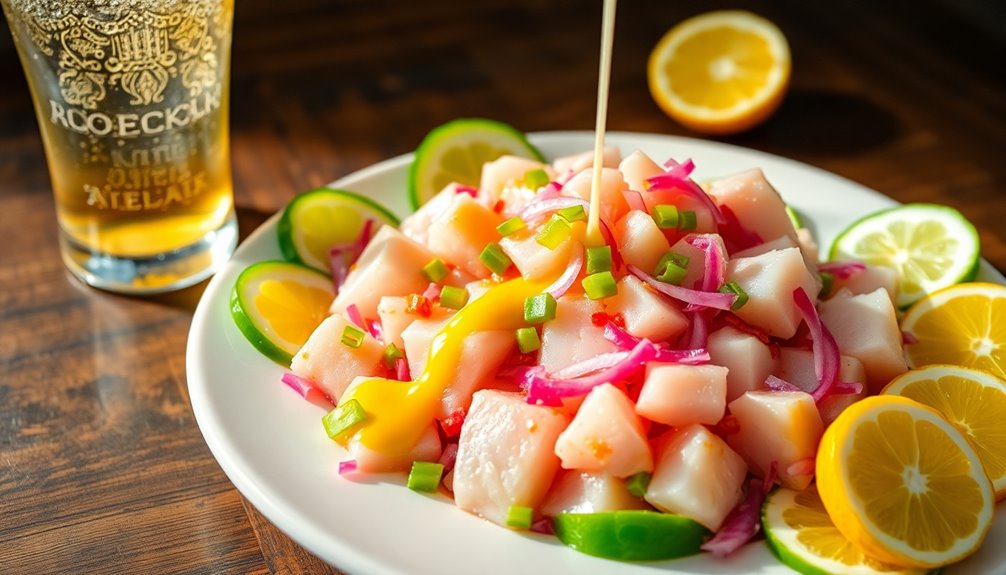
Kinilau not only delights the palate but also connects you to the rich cultural heritage of the Philippines. This traditional dish, with its fresh seafood marinated in vinegar and citrus juices, showcases the importance of quality ingredients.
Its historical roots stretch back over a thousand years, revealing a culinary legacy that Spanish colonists documented in the 17th century. You can enjoy various kinilau variants that incorporate raw fruits and vegetables, adding depth to flavors and textures.
Often served as an appetizer or side dish, kinilau pairs beautifully with cold beverages, making it a favorite at gatherings. Don't forget the essential coconut vinegar, which preserves freshness and elevates the dish. Additionally, the rise of sustainable fashion has influenced culinary trends, encouraging the use of fresh, locally-sourced ingredients.
Dive into kinilau, and savor both its taste and history!
Frequently Asked Questions
What Is Kinilaw Made Of?
When you think about a refreshing seafood dish, you're likely considering a mix of fresh fish or shrimp, marinated in vinegar or acidic fruit juices.
You'll often add aromatics like onions, ginger, and chilies to enhance the flavors.
To counteract any fishy taste, you might include juice extracts from specific fruits.
Additionally, you can incorporate raw fruits and vegetables, like cucumber or bitter melon, for a unique twist on the traditional recipe.
Are Ceviche and Kinilaw the Same?
Imagine the sun-kissed shores of two vibrant cultures, where raw seafood dances in citrus and vinegar.
While ceviche and kinilaw share the spotlight as marinated seafood dishes, they're not the same. Ceviche typically leans on zesty lime juice, while kinilaw embraces the tang of vinegar and local fruits.
The seafood types and regional flavors differ, too, creating unique culinary experiences.
What Is Kilawin in English?
Kilawin, in English, translates to "grilled meat."
It refers to a popular dish in the northern Philippines where marinated meats, often pork or beef, are cooked over an open flame.
You'll find that the preparation is different from raw seafood dishes, focusing instead on the grilling aspect.
The blend of spices and marinades gives it a unique flavor, making it a delicious option for those who enjoy smoky, savory meats.
Did Kinilaw Come From the Philippines or Spain?
You might think kinilaw has Spanish roots, but it actually originated in the Philippines long before colonization.
Archaeological evidence suggests its preparation dates back over a thousand years, showcasing its indigenous heritage.
While Spanish colonists documented it in the 17th century, they noted its unique methods that differ from their ceviches.
Conclusion
In the end, making kinilau is like crafting a refreshing ocean breeze on a hot summer day. You blend flavors as vibrant as a tropical sunset, creating a dish that transports you to sandy shores with every bite. Whether you're sharing it with friends or enjoying it solo, you'll feel the warmth of island spirit in your kitchen. So go ahead, dive into this culinary adventure and let kinilau bring a taste of paradise to your table.
